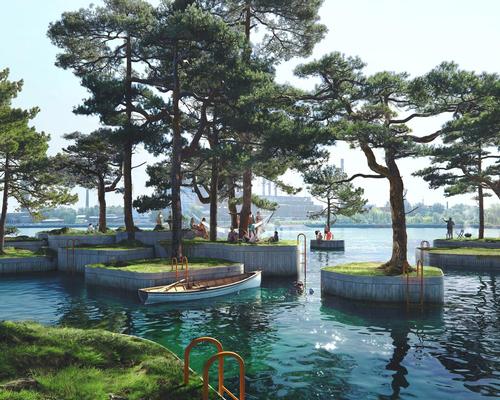28 May 2020
Copenhagen's 'parkipelago' project looks to redefine public parks
BY Tom Walker

A project involving hand-crafted islands on the Danish capital Copenhagen's waterfront is set to create a completely new genre of public parks.
Described as a "parkipelago", the Copenhagen Islands project will involve a number of islands being distributed to suitable locations around the city's inner harbour, with the aim of providing people moveable, floating, public spaces which will be free to explore and conquer.
During summer, the islands will be distributed to unused parts of the harbour, serving as "adventurous escapes" for the increasing amount of kayaks, leisure boats and general users of the harbour coastline.
During winter – and for special events or festivals – the islands can be brought together as a "super-continent", creating a cluster more easily accessed from the harbourside.
The not-for-profit initiative is the brainchild of Australian architect Marshall Blecher and Magnus Maarbjerg of Danish design studio Fokstrot.
"The islands will hopefully give back a little bit of space for whimsey and wonder to the old industrial harbour sides," the architects said in a mission statement on the Copenhagen Islands website.
"The parkipelago will focus on the place and function of public spaces in the city - both in a local context with rapid urban development along the harbour side, threatening the recreational spaces, but also in a global context with rising sea levels creating new challenges for urban environments."
The first of the islands to be released is CPH-Ø1, a small 20sq m, hand-made wooden platform with a linden tree at its centre.
It described as a "simple and iconic metaphor for an uninhabited island" and represents the first taste of the completely new type of public space.
Buoyed by recycled plastic bottles and made entirely from sustainably and locally sourced materials, the island is temporarily located in the Sluseløbet area of the harbour.
It was constructed by hand in the boat building yards in the south harbour of Copenhagen using traditional wooden boat building techniques.
CPH-Ø1 will be joined by CPH-Ø2, Ø3 and, eventually, many more.
Each island will serve as a platform for different activities – creating swim zones, floating saunas, floating gardens, floating mussel farms and a floating sail-in café.
Blecher and Maarbjerg say that the Copenhagen Islands will be one of many parkipelagos yet to be built.
Several harbours all over Denmark have undergone a huge development in recent years, changing rapidly as cities are expanding and sea levels are rising.
According to Blecher and Maarbjerg, "preparing for the future, the islands can be adapted and customised to each harbour, creating a unique and site-specific urban environment".
For more information on the project, click here:
Close Window